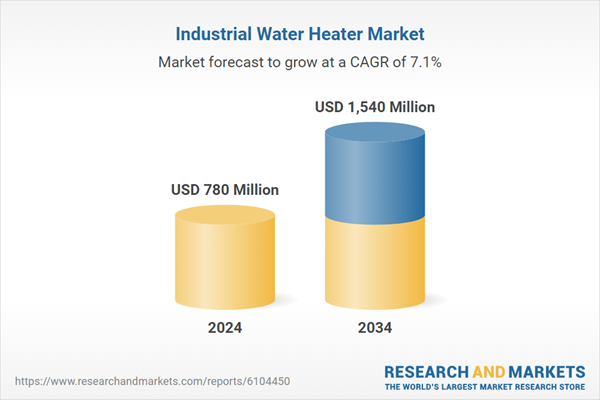Industrial operations are evolving rapidly, prompting manufacturers to adopt more reliable and advanced water heating technologies. There is a noticeable demand surge for systems that not only deliver consistent performance but also reduce operational downtime. These advancements are especially relevant for industries focused on optimizing their energy use while maintaining operational efficiency.
Sophisticated water heaters featuring advanced thermal energy technologies are now replacing older systems, reducing environmental impact and improving overall energy management. The growing emphasis on automated industrial processes is also contributing to the rise in demand, with smart features like predictive maintenance and AI-driven temperature control enhancing operational flexibility.
The increasing integration of digital infrastructure in manufacturing facilities is further supporting the adoption of modern water heating equipment. Industry 4.0 innovations are reshaping industrial heating landscapes, enabling facilities to anticipate maintenance requirements and avoid unexpected failures. This evolution is not just about improving performance but also about supporting scalable operations, especially for facilities dealing with seasonal or fluctuating processing demands.
By capacity, the industrial water heater market is segmented into three key categories: < 100 - ≤ 200 gallons, > 200 - ≤ 500 gallons, and > 500 gallons. Among these, systems with capacities ranging from < 100 - ≤ 200 gallons are gaining widespread attention, and their market is projected to exceed USD 200 million by 2034. These units are increasingly being adopted in settings that require flexible and modular heating solutions.
Their compact footprint, enhanced energy efficiency, and compatibility with smart technologies make them suitable for various industrial applications. The market’s growth in this segment is largely attributed to the transition from traditional fuel-based systems to modern, environmentally friendly alternatives that deliver high efficiency without compromising performance.
Based on application, the market is divided into several industries, including pulp and paper, food processing, metal and mining, chemicals, refinery, and others. Among these, the chemical industry accounted for the highest share in 2024, representing 25.6% of the total market. This dominance is fueled by a consistent demand for corrosion-resistant, high-performance heaters that can withstand aggressive chemical environments. The chemical processing sector prioritizes energy optimization, making high-efficiency water heaters essential for ensuring reliability and process stability in harsh operating conditions.
Regionally, the United States continues to demonstrate consistent growth in industrial water heater adoption. The market in the U.S. was valued at USD 35.5 million in 2022, increased to USD 43.7 million in 2023, and reached USD 46.7 million in 2024. This growth is primarily supported by regulatory mandates focused on energy conservation, as well as favorable tax provisions that encourage investments in high-efficiency equipment. Additionally, federal initiatives designed to reduce emissions from industrial facilities have further fueled the replacement of outdated systems with advanced heating solutions.
Prominent companies actively shaping the competitive landscape of the industrial water heater market include Ariston Group, A.O. Smith, Bradford White Corporation, FLEXIHEAT UK, Eemax, Hevac, Jaguar India, Hubbell Heaters, Lochinvar, Thermex Corporation, Sioux Corporation, Thermotech Systems, Herambh Coolingz, Viessmann, and Andrews. These players are constantly innovating to meet the growing demand for sustainable, smart, and durable water heating solutions across global industries. Their focus on product development, integration of smart technologies, and expansion into emerging markets is expected to continue influencing the competitive dynamics over the forecast period.
Comprehensive Market Analysis and Forecast
- Industry trends, key growth drivers, challenges, future opportunities, and regulatory landscape
- Competitive landscape with Porter’s Five Forces and PESTEL analysis
- Market size, segmentation, and regional forecasts
- In-depth company profiles, business strategies, financial insights, and SWOT analysis
This product will be delivered within 2-4 business days.
Table of Contents
COMPANIES MENTIONED
The companies featured in this industrial water heater market report include:- A.O. Smith
- Andrews
- Ariston Group
- Bradford White Corporation
- Eemax
- FLEXIHEAT UK
- Herambh Coolingz
- Hevac
- Hubbell Heaters
- Jaguar India
- Lochinvar
- Sioux Corporation
- Thermex Corporation
- Thermotech Systems
- Viessmann
Table Information
| Report Attribute | Details |
|---|---|
| No. of Pages | 120 |
| Published | June 2025 |
| Forecast Period | 2024 - 2034 |
| Estimated Market Value ( USD | $ 780 Million |
| Forecasted Market Value ( USD | $ 1540 Million |
| Compound Annual Growth Rate | 7.1% |
| Regions Covered | Global |
| No. of Companies Mentioned | 16 |









